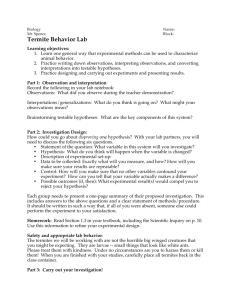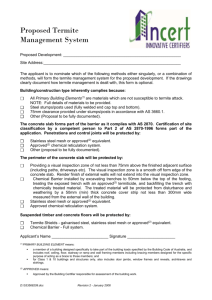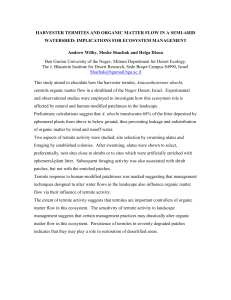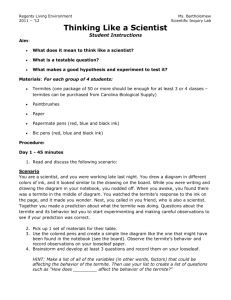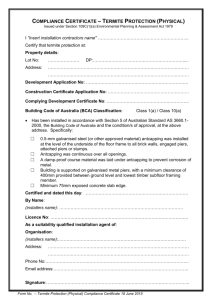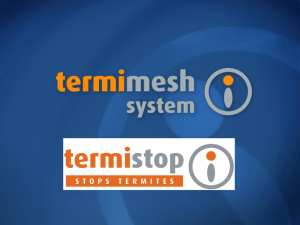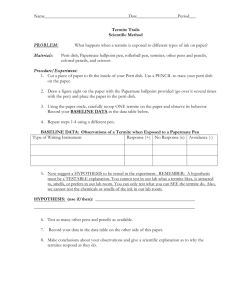Termite Management Systems - Queensland Building and
advertisement
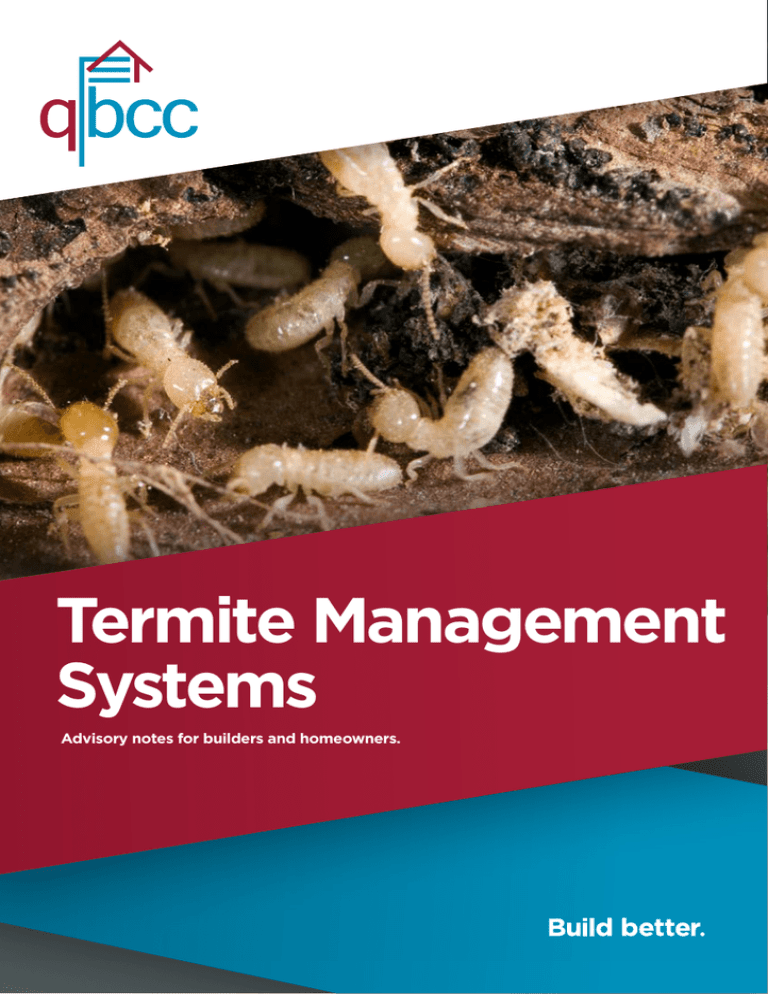
Termite Management Systems Advisory notes for builders and homeowners. Termite Management The information provided in this publication relates to Class 1 (houses, townhouses, terrace houses etc) and Class 10A (private garages, carports etc) buildings as defined in Volume 2 of the Building Code of Australia (BCA). qualified operators to carry out regular inspections. Termite infestations cause millions of dollars in damage each year to timber in homes across Australia. Termites (white ants) are a problem in most parts of Australia, but they are particularly active in hot, wet areas such as Coastal Queensland. For example, installing a water tank against a perimeter wall of a dwelling may breach the visual inspection barrier, allow termites to infest the building undetected, and void any warranty and insurance entitlements. The BCA requires all new homes to have some form of management to deter subterranean termite attack and there are many different methods available on the market. A home is usually the largest investment a person will make in their life, and the cheapest method of termite management may not be the most appropriate method for their specific site requirements. This publication informs builders, trade contractors, designers, pest controllers and owners of the facts behind the different types of termite management systems, and clarifies responsibilities for on-going maintenance requirements. A termite management system is intended to minimise the risk of termite damage to primary elements of a building through a concealed route. The installation of a termite barrier will not stop termite activity from occurring on the site. Owners must be proactive in the decision making process. And most importantly, they must ensure they arrange for appropriately licensed and Owners must also ensure they do not disturb or breach termite management systems, to maintain their warranties and insurance entitlements. Legal and Licensing Requirements significantly different to that of the building. For non-temporary Class 1 buildings this means that chemicals cannot be hand-sprayed unless it can be proven the chemicals will have at least a 50 year life span. If this cannot be achieved, it may be necessary for a reticulation system to be provided if chemicals are to be relied upon for termite management below a concrete slab Australian Standard Australian Standard 3660.1 - 2000 Termite Management - New Building Work is referenced in the Building Code of Australia (BCA). It is part of a trilogy of standards including Part 2 that deals with existing buildings and Part 3 that deals with assessment for termite management systems. Licensing • For chemical perimeter systems, the requirement is to excavate trenches, treat the exposed trench with chemical, backfill with a suitable material, then treat the backfill. On completion a 300mm wide x 50mm deep concrete protection layer (mowing strip) must be installed. • The definition of ‘Primary Building Element’ is extended to include door jambs, window frames and reveals, and architraves and skirting, in addition to structural members. • Installation of two durable notices in prominent locations. • The performance requirements also take into consideration accessibility for installation, maintenance and inspection of termite management systems. For example, hand-sprayed chemical perimeter barriers will not be suitable for zero lot line housing. Termite resistant materials or some other form of termite management will need to be considered at the design stage. The licences needed for termite management include the licence classes Termite Management Chemical and Termite Management - Physical. The latter class is restricted to particular physical systems such as graded stone or stainless steel mesh. A contractor must have one of these licences to provide advice or reports in relation to termite management systems or infestations. A QBCC licence is also required to install termite management systems in new building work. When applying a chemical system, a QBCC licence is required in addition to a Government issued (occupational) Pest Control Operator’s licence. Professional indemnity insurance to a minimum value of $500,000 is also required for licensees holding a Termite Management - Chemical licence. Building Code of Australia (Queensland Provisions) The BCA as it applies in Queensland, has a variation that requires: • The ability to replenish a chemical termite management system where the life of the chemical is What does building law require? The Building Code of Australia contains the minimum technical provisions of the Queensland Building Act 1975 related to the protection of buildings from damage by subterranean termites. Any termite management methods that can be shown to meet the BCA performance requirements with documented evidence, may be accepted by the building certifier or approval authority. In Queensland, the risk of primary building elements being damaged by subterranean termites must be minimised and provide for a 50 year design life. For houses and associated sheds, carports, garages, etc, clause 3.1.3 of Volume 2 of the BCA specifies the means of satisfying the performance requirements. In the case of termite control, compliance with any of the systems (or a combination of them) detailed in AS 3660.1 satisfies BCA clause 3.1.3. AS 3660.1 provides a range of termite management measures that may be used, including chemical or physical barriers or a combination of any of these. NOTE: Clause 3.1.3 must be read in conjunction with the Queensland Amendment to the BCA. System solutions for termites Regular inspections Method of attack Regardless of the system used, regular inspections should be carried out by a QBCC-licensed contractor with the appropriate Termite Management licence to ensure termites have not bridged the barrier. It is recommended that inspections be at least every 12 months, or more often in high risk areas. Attacks on buildings usually originate from a nest below the ground. Termites build mud galleries when they are at risk of being exposed to enable them to travel over piers or walls to attack wood and wood products in buildings. Usually, the nest is outside the building perimeter but occasionally a nest may be buried in the soil beneath the building. Termites can get inside a building via wall cavities, cracks in mortar or concrete slabs and voids adjacent to service entry points. Most infestations occur at the perimeter of the building and usually result from owners being unfamiliar with “good practice”. For example, an existing termite management system can be bridged by building garden beds or placing wood chips up to the house, or by attaching unprotected structures such as carports, pergolas and fences to the house. To expose termite mud gallery into weephole opening - ensure 75mm minimum clearance to garden bed 1. Chemical Systems Chemical deterrent systems are normally used in conjunction with slab-on-ground construction. Traditional chemical treatments incorporate a chemical reticulation system under the slab and around the perimeter of the building. AS 3660.1 specifies the procedures to provide a chemical system that will deter termites from gaining concealed access to termite-susceptible elements in the building. Section 8 of the Standard does not refer to any specific chemical. Instead it allows the use of any chemical that is registered for the purpose by the Australian Pesticide and Veterinary Medicines Authority (APVMA). This allows for the introduction of any future approved chemical. (APVMA is a Commonwealth organisation responsible for the registration of all agricultural and veterinary chemicals). Most chemicals used in termite management have a limited life span. It is recommended you contact the manufacturers of products for information about the life expectancy of these products and details of the label conditions that must be adhered to when they are used in termite management systems. Queensland provisions of the BCA require proof that hand-sprayed chemicals under concrete slabs have a reasonable life span before they can be used. If, during the regular competent inspection of a building a termite infestation is discovered, re-treatment may be necessary to remove the problem and ensure the building is given protection to minimise the risk of termite damage. A convenient means of re-treating under slabs is through a reticulation system. Reticulation systems need to be installed under the slab prior to pouring concrete. A reticulation system will allow periodic re-charging from outside the building. Owners should educate themselves before making a final decision about the method of control to use. Ask your builder, designer or other competent person about the proposed termite control method, and on-going maintenance responsibilities. CHEMICAL SYSTEMS NOTE: IF THE EXPECTED LIFE OF THE CHEMICALS TO BE USED IS LESS THAN THE EXPECTED LIFE OF THE BUILDING AND THOSE CHEMICALS ARE INACCESSIBLE, A RETICULATION SYSTEM MUST BE INSTALLED TO ALLOW FOR REPLENISHMENT OF THOSE CHEMICALS 2. Physical Systems Until recently, physical systems have been restricted mainly to suspended floor construction (e.g. houses built on stumps). The traditional physical system is the ant cap. Ant caps are placed on the tops of stumps and piers etc. Ant caps do not prevent termites from getting into the building, they merely act as a barrier to concealed entry and encourage the termites into the open where they can be noticed during inspections. METAL FLASHING The metal flashing installed in cladframed slab-on-ground construction should not be confused with traditional ant capping. A termite management system such as an exposed slab edge is required in these circumstances. A number of other physical systems are available that are suited to slab-on-ground construction. In many cases they can also be used in elevated houses. 3. Graded Stone Graded stone systems incorporate carefully graded and shaped, high quality granite particles that can be placed in a layer under the entire concrete slab area, around the base of stumps in an elevated building, as a partial system around the perimeter of the building or around individual penetrations. Combinations of physical and chemical systems may sometimes be necessary. The system works on the principle that the particles, when placed and compacted, will not allow the termites to find a path through them. The particles are too hard to eat and are too small to allow the movement of termites between the abutted particles. GRADED STONE NOTE: under floor graded stone fill treatment (minimum compacted depth 75mm). Alternatively the underfloor graded stone can be omitted and the penetrations through the slab protected by an approved system. 4. Stainless Steel Mesh Stainless steel mesh systems incorporate finely woven, high-grade stainless steel mesh. This can be used in the same manner as the traditional ant cap, being placed under the entire concrete slab area, around the perimeter of the building as a partial barrier, or around individual penetrations. Combinations of physical and chemical systems may sometimes be necessary. The manufacturer maintains the grid pattern of the mesh is fine enough to not allow termites through, and strong enough to prevent them from chewing through it. Being stainless steel, it is unlikely to be affected by the corrosive nature of some concrete and ground conditions. Termites can still gain access through penetrations that pass through the STAINLESS STEEL MESH floor (such as plumbing pipes), and/ or via the building’s perimeter. These areas require additional control using chemical or physical systems. If chemical treatment is used to protect penetrations in the concrete floor, the whole of the under-slab area must be treated. If physical systems are used, only the area around the penetrations needs to be protected. The BCA requires only the primary building elements of a building to be protected against damage by termites. The definition of ‘primary building elements’ in this instance has been extended in Queensland to include door jambs, window frames and reveals, architraves and skirting. This is in addition to the roof structure, load-bearing walls, beams, floor structures etc. 5. Concrete slab as termite barriers Most infestations occur at the perimeter of the building. Constructing concrete slabs in accordance with Australian Standards significantly reduces the likelihood of major cracking in concrete slabs, which could permit termite access. The standards include AS 2870- Residential Slabs and Footings Construction and AS 3600 - Concrete Structures. edge will not stop termites from gaining access into the building, but it will encourage them out into the open where termites can be noticed and identified. Baiting can then be applied and the nest destroyed. CONCRETE SLAB BARRIER These standards support using the concrete slab as a termite barrier. This is reflected in 3660.1-2000. Any of the physical or chemical systems previously mentioned can be used for termite management treatment around a building’s perimeter. Another cost-effective physical system uses an exposed slab edge. The exposed slab Termite resistant materials The BCA allows termite resistant materials that protect primary building elements. Termite resistant materials include: Steel: Steel frame systems can consist of steel floor, wall and roof framing. Concrete: A concrete slab-on-ground can itself form a termite barrier. The slab needs to be constructed in accordance with AS 2870 and AS 3600. Timber • Naturally termite resistant timber in accordance with Appendix C of AS 3660.1-2000 • Preservative treated timber in accordance with Appendix D of AS 3660.1-2000. This can consist of Light Organic Solvent Preservative (LOSP) to Hazard Level 2 or 3 (H2 and H3). Treatments to H4 and H5 levels are required externally where timber is in contact with the ground. This treatment can also be extended to include window reveals, door jambs, architraves and skirting. Where termite resistant materials are used for primary building elements as a termite management system in accordance with the BCA, additional termite barriers may not be necessary. Prospective home or building owners are encouraged to consider ‘whole of building protection’. There are many options to consider that builders and owners should discuss. The site conditions, building design and the owner’s requirements, such as ongoing maintenance, all need to be consided before signing a contract. Alternative solutions There are several products on the market that may be accepted by Building Certifiers as meeting the performance requirements of the BCA. The use of alternative solutions must be discussed with the Building Certifier prior to any works commencing, for example before, but no later than at the Building Approval stage. Where a project design offers a combination of building systems, such as slab-on-ground and timber frame, and split-level floor system that does not suit a particular termite deterrent method, the owner or builder may choose an alternative or combination of methods that are cost-effective and most suited to the building design. Combination systems Some system installers may not be prepared to honour their warranties where a combination of systems is used. Split-level and zero-lot-line buildings are two examples of the need to incorporate physical deterrent systems or termite-resistant materials. A chemical deterrent system alone may not be adequate in some cases. Particular attention needs to be given where split level slab-on-ground or composite slab-on-ground and suspended floor framing are to be incorporated. It is likely that, as in the diagram, a combination of systems will need to be incorporated. Where a combination of different types of protection is proposed, ensure that warranties apply to the unique systems being used. COMBINATION TERMITE BARRIER SYSTEM Suspended floors The area beneath a suspended floor is one of a building’s most susceptible areas to termite activity. To be effective, termite management systems installed in this area rely totally on access for both inspection and treatment if termite activity is detected. To ensure access is always available to the sub-floor area, an access door or panel must also be provided. AS 3660.1- 2000 contains provisions for sub-floor clearance under suspended floors to allow for visual inspections. Where the building has a suspended floor, cross flow ventilation must be provided under the floor. This is to discourage termite activity and to reduce the likelihood of damage to sub-floor members by fungal attack. Depending on the location of the work, BCA sets out minimum requirements for ventilation per lineal metre of both internal and external walls. Ventilation openings must be placed below damp-proof courses but above the level of possible entry of surface water. A minimum clearance of 400mm is generally necessary between the finished ground level, structural components and any other obstruction (bearers, floor joists, plumbing pipes etc). The required clearance can be reduced from 400mm to 150mm provided the area slopes to and is not more than 2m from a point conforming with the required 400mm minimum clearance. COMBINATION TERMITE BARRIER SYSTEM Choosing a system Termite management systems should be based on carefully selected deterrent methods and include regular competent inspection. QBCC recommends using an acknowledgement notice before signing a building contract. The notice confirms that termite management has been discussed in detail between the builder and owner before signing a contract. It details the termite management system to be incorporated into the works and acknowledges that alternative systems have been discussed between the builder and owner. Building associations and other organisations may also provide a similar document for this purpose. The cost of control methods and the effective life of the treatment can vary considerably, as can ongoing costs and renewal treatments. While comparing costs and the effective life-span of treatments, also compare the warranty benefits of the different control methods before committing Installation process Submitting an application During construction The termite control method must be detailed on the drawings and specifications accompanying building applications. Check with your approving authority or building certifier to determine what systems are acceptable. The building certifier (or approving authority) may require the licensed installer to certify that the system has been installed according to AS 3600.1-2000. Where an accredited product has been used, it must be installed according to the conditions specified in the accreditation certificate. For approved systems that use stainless steel mesh, granite particles or reticulation systems, the system may be acceptable by name. Where construction techniques, such as an exposed slab edge or termite resistant materials, are to be used, specific details are usually required. Certain construction techniques or practices such as timber treatments or timber species need to be documented by the builder as evidence of building compliance with AS 3660.1-2000. The certificate should contain the following information: • Date • Owner’s name • Builder’s name • Property location • Real property description • Building description • Details of termite deterrent work undertaken, including a diagram where appropriate • Areas (m2) of the procedures for termite management which may be due to the building design or owner’s requirements. Site practices Trade contractors need to take care when working in and around buildings where there is a risk of compromising termite management systems. It is essential to be familiar with the type of termite management system used, and its current status. If there is any ambiguity, clarification should be sought before undertaking any work. For example, a concreter may need to have treatment applied or a reticulation system installed beneath a concrete slab-on-ground where that slab abuts a building. This can include driveways, carport slabs and footpaths. A landscape contractor installing paving, concrete pathways or gardens adjacent to and abutting a building will also need to consider how to manage the termite risk. Plumbers and drainers need to pay particular attention to maintaining the termite deterrent system when installing pipe work connections to buildings. Installing concrete protection blocks over exposed pipe work and at inspection points can provide an easy point for concealed entry by termites. In the case of chemical perimeter systems, these protection blocks need to be placed in position after the system has been installed, being careful not to disturb the system. This also applies to electrical contractors who should be careful that electrical conduits do not provide an avenue for termite entry, and to contractors installing any other services connected to a building. Builders must be vigilant in supervising the building process to ensure the termite management system is installed correctly and not compromised by other aspects of the building process. This includes the removal of any debris and mortar slag from footings before or as part of site cleaning prior to the installation of a chemical system. All form work, set- out pegs and timber profiles also need to be removed well clear of the termite management system area. Where construction is of a composite nature, such as where a split level slab-on-ground forms part of the building or where retaining walls form part of the structure, special consideration is needed to establish an effective termite management system. A chemical system alone may be inadequate. When using chemical termite management, sandy loam is a suitable soil type. The use of crusher dust or stone and rubble is not appropriate. Termite management contractors need to check that soil conditions are suitable before applying any chemical. At building completion When the work is finished, the builder should give the owner information on the termite management system installed and the owner’s ongoing maintenance responsibilities. In the case of chemical systems, it may be appropriate for an owner to enter into a contract with a QBCC-licensed termite management contractor for inspection and ongoing treatment as recommended by the label on the product used to form the system. The owner may have to declare to the local government that they are aware of the termite control system used on the building including constraints and ongoing maintenance provisions. The declaration should be on a form approved by the local government. The declaration should describe the system used and contain details of the competent person who gave the advice on the management system and its constraints. Generally, advice from the builder and system installer/consultant should be sought. Notices The BCA requires a termite control notice to be permanently fixed to the building in a prominent location (such as the meter box). In Queensland, two durable notices are required, both indicating: • The method of protection • The date the termite management system was installed • Where a chemical system is to be used, its life expectancy as listed on the APVMA label • The installer’s or manufacturer’s recommendations for the scope and frequency of future inspections for termite activity. Future building owners should be made aware of the termite management system used on the building. The onus is on the buyer to make themselves familiar with the on-going maintenance requirements of the system. Termite management after moving in It is important for the owner to understand that properly installed and maintained termite management systems impede and discourage concealed termite entry into buildings. They do not always prevent unconcealed entry and therefore do not prevent termite attack. Owners should find out what type of termite management system has been installed in their home. For example, they should know what type of chemical and/or physical system has been installed (e.g. concrete slabs, exposed slab edge, metal shielding, stainless steel mesh or graded stone), if termite resistant materials have been used, or what combination of chemical and/or physical and/or termite resistant materials are in use. Termite management is required below and around the perimeter of the building. Generally, physical systems will be designed to last for the lifetime of the building with proper maintenance. Chemical systems have a limited life and therefore require ongoing treatment. Pre-purchase inspections Satisfactory completion of a pre-purchase Building Inspection is usually a pre-requisite to the purchase of a home. A pre-purchase Building Inspection should be carried out by a contractor appropriately licensed by QBCC and should assess the general condition of the property and discover any major defects in accordance with Australian Standard 4349 Part 1. In addition to the Building Inspection, a pre-purchase Timber Pest Inspection is recommended. The Timber Pest Inspection should also be carried out by a contractor appropriately licensed by QBCC. Part 3 of AS4349 provides minimum requirements for a noninvasive Timber Pest Inspection and report on timber pest activity within the house and for the surrounding property within 30 metres of the building. According to the Standard, the noninvasive pre-purchase Timber Pest Inspection is a visual inspection that includes non-marking sounding of elements and assessment of the moisture content of materials. The definition of timber pests excludes dry wood termites and mould, but includes subterranean and damp wood termites, borers of seasoned timber and wood decay fungi. The Timber Pest Inspection Report should comment on evidence of present or past timber pest activity and associated damage, and any indications of previous timber pest treatments. It should also provide an assessment of the susceptibility of the building to attack by timber pests, indicate any conditions that could increase the potential for timber pest activity, and where necessary, make recommendations for further investigation or action. Any Timber Pest Inspection will be limited by the inspector’s competencies and affected by any impediments to the inspectors work at the time of the inspection. Impediments may include deliberate concealment of pest activity, areas or items that cannot be inspected for any reason, prevailing weather conditions, or the quality and accuracy of information provided by the homeowner or their representative. Reduce the risks To deter concealed termite entry to the dwelling, regular maintenance is essential. The following list is a guide to what owners should and should not do to protect their home from termites. • Have the building inspected at least annually by a suitably qualified termite management contractor, licensed in Queensland by QBCC. A free licence history check can be performed at www.qbcc.qld.gov.au. More frequent inspections may be required in high risk areas (such as areas near trees or bush). NOTE: Concrete paths or driveways placed against a building may require a chemical reticulation system to be installed in the ground before concreting. • Installing new services involving underground connections to the house (such as pay TV) • Installing new water tanks against the dwelling spanning over the width of the termite management. • Ineffective The most frequent cause of termite infestation is where a perimeter system has been bridged or breached, thus rendering it ineffective. Constructing a pergola (75mm minimum clearance is recommended between the finished ground or pavement level and the bottom of the timber posts) • Special care should be taken to protect the ‘weep holes’ (vertical joints between bricks close to ground level that are left open to allow any moisture to escape outside the house). 75mm minimum clearance is recommended from the bottom of any weep hole to the top of the garden bed, concrete or unit paving. Attaching fences, carports, or garages to the home. You should ensure the soil surrounding members in contact with the ground is treated. More information on termite system maintenance can be found in Australian Standard 3660 - Control of Buildings From Subterranean Termites - Part 1: New Buildings. See back page for more suppliers. • Owners should be careful not to compromise their termite management system. Termite infestations can occur when a perimeter system has been made • Placing turf, paving, concrete paths, bark and garden beds up against the house wall (you may need to reestablish the termite system). Leaving loose timber stacked up or leaning against the house. Owners should perform their own ongoing inspections between professional inspections. • • • • • Some common practices that may increase the risk of termite problems include: Freestanding structures should be built with a minimum 25mm inspection zone between the structure and the house. The Australian Standards mentioned in this publication can be purchased from SAI Global. For full information visit their website saiglobal.com.au. The following organisations may also be able to provide information on the legislative requirements applicable to termite management. You may also contact your local council or private building certifier Queensland Building and Construction Commission Telephone: 1300 272 272 Website: qbcc.qld.gov.au Building Codes Queensland Telephone: 3239 6369 Website: dip.qld.gov.au Australian Environmental Pest Managers Association (AEPMA) Telephone: 1800 25 27 72 Website: aepma.com.au Timber Queensland Telephone: 3254 1989 Website: timberqueensland.com.au Queensland Master Builders Association Telephone: 3225 6444 Website: masterbuilders.asn.au Telephone: 3846 1298 Website: hia.com.au Department of Employment, Economic Development and Innovation Telephone: 132 523 Website: dpi.qld.gov.au Queensland Health Telephone: 3234 0111 Website: health.qld.gov.au Building Designers Association of Queensland Telephone: 3889 9119 Website: bdaq.com.au Insurance Council of Australia Telephone: 1300 728 228 Website: insurancecouncil.com.au Need more information? Visit qbcc.qld.gov.au or call us on 139 333. QBCC20150722_FCTbrTermite Housing Industry Association 299 Montague Road, West End Qld 4101 GPO Box 5099, Brisbane Qld 4001 T: 139 333 F: 07 3225 2999 W: qbcc.qld.gov.au
